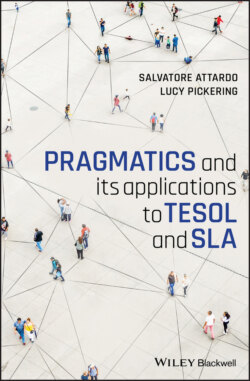Читать книгу Pragmatics and its Applications to TESOL and SLA - Salvatore Attardo - Страница 44
3.3 Speech Acts in SLA and Applications to TESOL
ОглавлениеThe investigation of speech acts in SLA and its applications in classroom instruction is one of the successes of the story of pragmatic instruction in TESOL. This is in part because it is “low hanging fruit” compared to many other aspects of pragmatics. As we noted in Chapter 2, every language develops ways to request something or apologize to someone because they are ubiquitous acts in human interaction, but not every language may develop highly ritualized uses of honorific particles, for example. In addition, because of the pervasive nature of speech acts, their expression is highly conventionalized as we noted earlier. For example, in American English, apologies typically comprise three parts:
1 the reason for the apology (e.g., I’m so sorry I’m late);
2 explanation of responsibility (e.g., the bus was late/You know me, I’m never on time); and
3 offer of repair/promise that it will not happen again (e.g., I’ll catch up with Tom regarding the meeting/This won’t happen again; Blum-Kulka & Olshtain, 1984).
There are also expected sociopragmatic contexts in which they are performed (e.g., coming in late for a meeting) and standard pragmalinguistic formulas with which they are expressed (e.g., I’m so sorry, I want to apologize). Any one of these three facets of speech act production can change cross-culturally. We can demonstrate this using the speech act of complimenting.
In American English, Herbert (1986) suggests that a compliment structure is a two-part routine, and the response to the initial compliment will be one of three choices:
1 Agreement (e.g., thank you, I love it!);
2 Nonagreement (e.g., it’s just an old shirt); or more unusually,
3 Other interpretations (e.g., an offer such as would you like to borrow it?).
In Chinese, however, Chen (1993) suggests that Rejection or Nonagreement is a far more common response. From a sociopragmatic perspective, compliments in American English tend to appear in interactions between people of equal status such as between friends or colleagues, whereas in Japanese, speakers are more likely to compliment people of a higher social status than themselves. Finally, pragmalinguistically, Chen (2010) suggests that compliments in American English typically take the structural form NP is/looks really ADJ (Your blouse looks really beautiful), or I really love/like NP (I love your car) (p. 79), while in Arabic, a common response is a formulaic utterance of offering, for example, I proffer it to you; It’s all yours (p. 93)
As we noted in Chapter 2 much of the research in SLA has focused on examining how these differences are learned in a second language, and a number of syntheses of interlanguage speech act studies (Kasper & Rose, 1999; Plonsky & Zhuang, 2019; Taguchi, 2015; Takahashi, 2000) give us a clear picture of the development of this field. Early studies were typically experimental in nature and used elicited data such as dialogue completion or roleplays; see Chapter 9 for a detailed discussion of these designs. One effect of this line of research noted by Kasper and Rose (1999) is that low-proficiency learners may not have sufficient overall language competence to engage in these kinds of language activities; thus, primarily intermediate and advanced learners are investigated. A consistent finding across these studies is that similar to native speakers, learners control a wide range of strategies with which to enact speech acts; for example, they use both direct and indirect strategies and they understand the necessary components for effective speech act performance such as offering repair in the case of apologies. In contrast, their pragmalinguistic choices differed from native speakers. This would not be unexpected as the language used in these contexts may be idiomatic in nature (e.g, got a light?). Blum-Kulha and Olshtain (1986) found a bell-shaped development curve in the use of modality markers such as hedges, supportive moves, or intensifiers (see Section 7.1, for discussion) used with speech acts where they were initially under-supplied at lower-proficiency levels, and then oversupplied at higher levels before they reached a more nativelike distribution. The use of modals also developed over time from an overuse of (I) want or bare imperatives (e.g., give me) toward more nativelike uses of may (I), would (you) and could (you) (Hill, 1997).
Later research focused on how sociopragmatic and pragmalinguistic features might best be taught. Overall, studies showed a clear, positive effect for explicit intervention suggesting that Non-Native Speaker (NNS) pragmatic competence can be positively impacted through classroom instruction even in EFL environments. For example, Eslami-Rasekh et al. (2004) administered a multiple-choice awareness test to both a control and treatment group of Iranian learners following 12 weeks of metapragmatic instruction in requests, apologies, and complaints for the treatment group, and a significant difference in performance was found between the two groups. Rose and Ng (2001) report a similar finding for deductive instruction of compliments and suggest that it may be particularly effective for increasing learners’ sociopragmatic knowledge. These findings regarding the effectiveness of explicit treatments of speech acts have been further confirmed by the most recent studies that have come to similar conclusions particularly within EFL contexts (Eslami-Rasekh, et al., 2015; Nguyen et al., 2015; Sarab & Alikhani, 2016; Zaferanieh & Eslami-Rasekh, 2016). Investigation of the effectiveness of different instruction techniques also continues to expand. Most recently, Taguchi and Kim (2016) investigated the potential benefits of task-based teaching and collaborative dialogue between students. Following instruction, two groups of EFL learners in South Korea developed their own request dialogues: One group developed them collaboratively in pairs and the other group worked on them individually. Language produced during the collaborative task and in the immediate post-test showed an advantage for the collaborative group; however, in a delayed post-test conducted one month later both groups performed alike.
